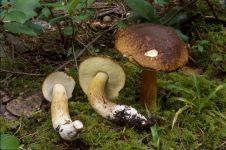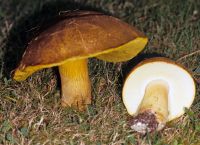Distribution: Widespread in the PNW
Habitat: Occurs in old-growth forests of fir and western hemlock as well as earlier succession forests of western hemlock and Douglas-fir and other mixed forest stands.
Conservation Status: Not of concern
Edibility: It is edible, but inferior to B. edulis.
It is edible, but inferior to B. edulis.
Cap: 6-17 cm broad, convex to more or less plane; surface dry, minutely velvety becoming fibrillose or sometimes fibrillose-scaly at the center; brown to dark brown to cinnamon-brown, sometimes with paler blotches or paler at the margin (but not yellow). Flesh thick, white or brown, not blueing when bruised; taste mild. Pores: pale yellow to yellow or dingy olive-yellow (occasionally pallid when very young), not bruising blue. Stalk: 8-16 cm long, 2-4 cm thick at apex, equal or thicker below (but sometimes pinked at base); solid, firm; light brown to brown (often paler than cap); apex often yellow and/or base whitish; usually lined or fibrillose, reticulate at least at the top.
Sources: Arora, David. Mushrooms Demystified. Berkeley, Ten Speed Press, 1986. Trudell, Steve and Joe Ammirati. Mushrooms of the Pacific Northwest. Portland, Timber Press, Inc. 2009.
PNW Herbaria: Specimen records of Boletus fibrillosus in the Consortium of Pacific Northwest Herbaria database.
CalPhotos: Boletus fibrillosus photos.




